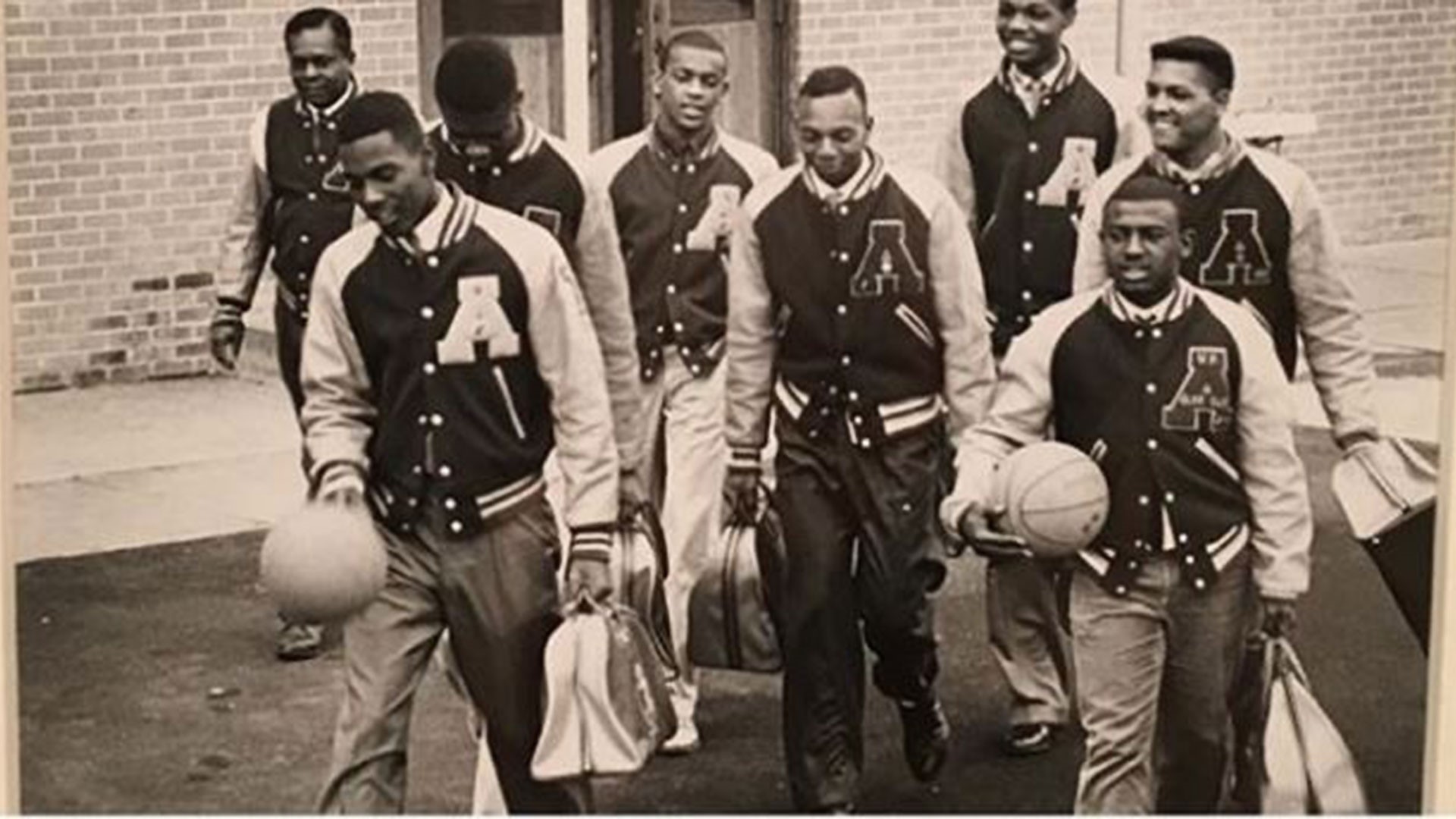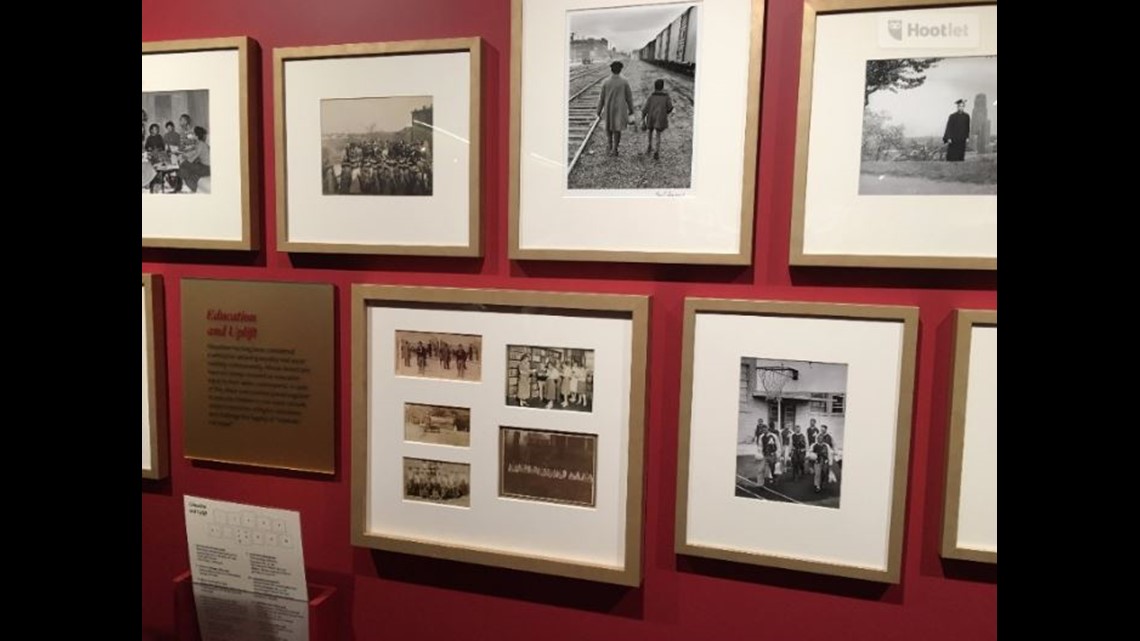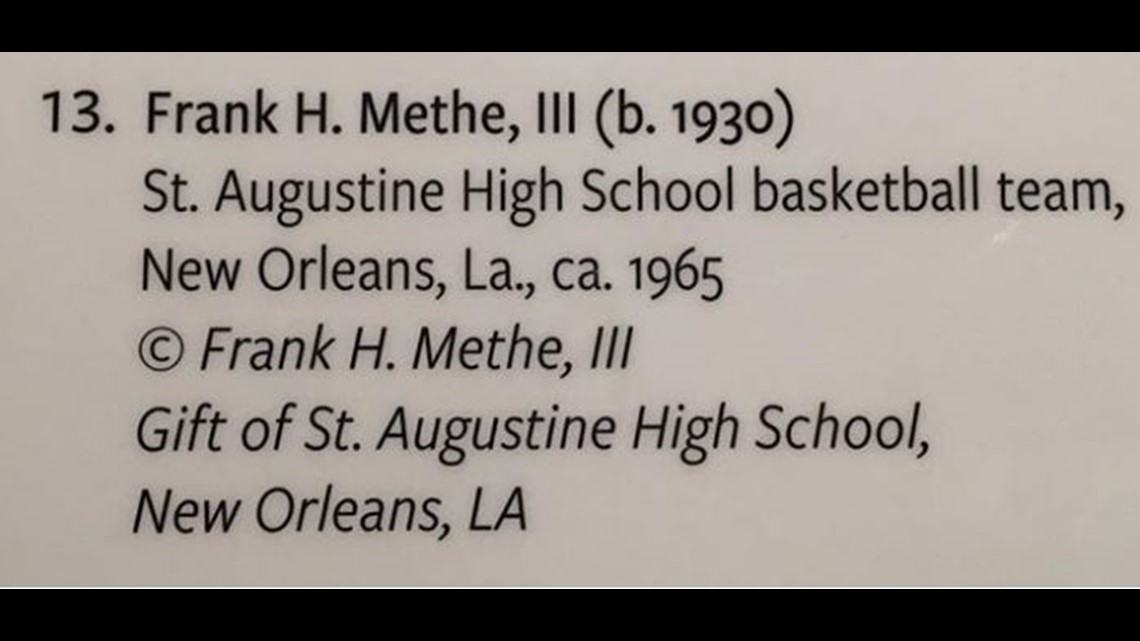Photo of St. Aug basketball team featured in Smithsonian African-American museum
The image of the 1965 St. Aug basketball team sits in an exhibit dedicated to sharing 100 powerful moments in African-American history, culture, and community.

NEW ORLEANS -- There are 36,000 artifacts that made it into the recently opened Smithsonian Museum of African-American History and Culture.
One of them originated in the halls of St. Augustine High School, at the dawn of the Civil Rights Movement and before integration of the Louisiana High School Athletic Association.
The history behind the photo
'The basketball team practiced on dirt, with basketball goals installed when I was a student.'
The image of the 1965 basketball team sits in an exhibit dedicated to sharing 100 powerful moments in African-American history, culture, and community.
However, what you don’t see is a team of young men who were expected to perform well academically and athletically, even in the face of adversity.
“That photo predates us even having a gymnasium for us to play in and practice in,” said Dr. Kenneth St. Charles, President and CEO of the school. “So not only were these young men, these students, not only were they capable and ready to play against whatever school, they didn't have the same resources.”
St. Charles, also an alum of the school, said knowing the back story of the photo gives it greater meaning.


“The basketball team practiced on dirt, with basketball goals installed when I was a student,” St. Charles said. “The yard was just basketball goals. So the average person wouldn't know that, but us, we know. I think there's a story behind that photo, I’m glad they picked that photo.”
“I had an opportunity to speak to one of the men that is in the photo, Richard “Deanie” Solomon,” explained Aulston Taylor, development committee member of St. Augustine High School. “At the time they were not allowed to play against any other Catholic schools, but what he noted was the unison. He stated to me how whatever they did, they did it in the exact same manner and order. So, if you look at the photo you’ll see that the guys are all dressed alike, their bags are the exact same, and they’re one.”
First black team in the Catholic league
'I didn’t remember the picture per se, I just remember the guys.'
A year after the photo was taken, Father Robert Grant, then principal of the school, filed a suit challenging the segregated Louisiana High School Athletic Association and won.
“I didn’t remember the picture per se, I just remember the guys,” said Richard “Deanie” Solomon, one of the photo’s subjects. “I didn’t know it was being taken.”
When the museum opened in September, Solomon said he started receiving calls that a photo with him in it was featured.
“I just kind of reminisce, think about the old days about life in high school,” Solomon said when he saw the photo.
Solomon was a senior in high school when the LHSAA was integrated.
“We were just thinking about, as far as black and white were concerned, we wanted to represent,” he explained. “I was 16, 17, a kid.”
Now, Solomon serves as an assistant football coach at Florida A&M University. He said when he comes back to New Orleans to recruit, the fact he was on the first black team in the Catholic league is still talked about.


Before the 1966 federal suit was won, St. Augustine dominated competition against the all-black public schools, gaining the school regional recognition which has continued through the years. Now, being recognized in a Smithsonian museum brings another facet for the school to be viewed nationally.
“I was really excited that the school had this kind of exposure,” said Solomon. “It’s a pretty well known school around the country, but now just the everyday person that visits (the museum) sees us.”
A four-year process
‘A good friend of mine reached out to me randomly…’
Getting the photo into the museum was a four-year process.
“A good friend of mine, who I went to college with reached out to me randomly on Facebook,” explained Taylor. “She sent me a note saying there was ‘a museum going to be opening in D.C. I know you have a real passion for your high school, you guys seem as though you have significant contributions to the world, you should definitely look into being in here.’”
Taylor said he got that note November 2012. After sending details about the school, he had a hand in going through the Josephites archive in Baltimore. The Josephites started the high school in 1951, and it was one of the only Catholic school options open for black students.
About 25 original photos were chosen to submit to the museum.
“Two years later, in 2014, an acceptance letter came to me stating that the museum was indeed going to keep it,” said Taylor. “Fast forward to September 2016, the museum opened up, and we were there.”
Giving back to continue the legacy
“No matter how often you try to understand what this spirit is that looms these halls, it's just something that we know.”
“A lot of people always want to know, what’s the secret?,” said Dr. St. Charles, when referring to the school pride anyone who comes in contact with alumni from St. Augustine can feel. “Why are you guys so close to each other? What's the bond?”
St. Charles explained every day he can see the history of the people who walked the halls before him, and knows he must leave a lasting impression for the students in his charge.
“To see our story, our history, our founding teacher, students giving their just due for what they did, it’s very humbling to me as an alum, as an employee, and now the leader of this school,” he said.
Another subject of the photo is Coach Nick Connor, who was the school’s first basketball and football coach, and the first layperson hired by the Josephites to work at the school.
“He taught me science,” said St. Charles. “I can’t speak for the student players, but my recollection, Coach Conner had a very calming attitude and disposition. The Josephites that hired him, they needed a lay cadre of people and going back to the inception of the school, they brought in very dedicated and committed people. So his spirit not only guided that team but also the young man, students and athletes for years and years to come.”
Taylor, who spearheaded the application process to the museum, said it was something inside of him that pushes to give back to his school.
“No matter how often you try to understand what this spirit is that looms these halls, it's just something that we know,” he said.
All three men mentioned their need to give back to the place that instilled so much in them.
“Guys have always helped guys that have come out of the program, and for a number of different reasons, people who've left have become successful,” said Solomon of the school. “It was always a strong community, with an academically strong background. That helps you once you get out. I recognize it even more so now, because I was fortunate to have some success when I went in as a young guy, looking up to juniors and seniors, that I could carry on their tradition, which is always important.”
A tradition that continues today, and can now be remembered by dozens of visitors to the museum.




